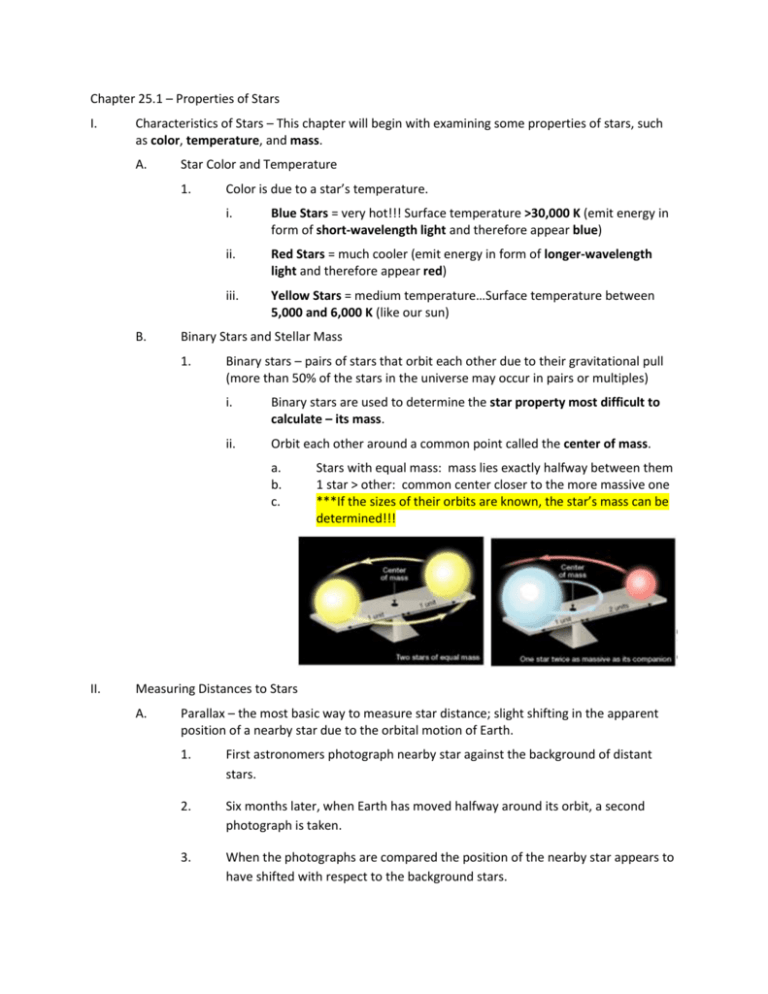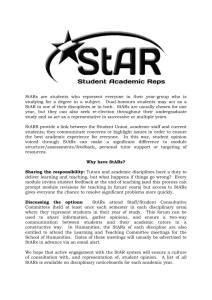Chapter 25.1 – Properties of Stars I. Characteristics of Stars – This
advertisement

Chapter 25.1 – Properties of Stars I. Characteristics of Stars – This chapter will begin with examining some properties of stars, such as color, temperature, and mass. A. Star Color and Temperature 1. B. Color is due to a star’s temperature. i. Blue Stars = very hot!!! Surface temperature >30,000 K (emit energy in form of short-wavelength light and therefore appear blue) ii. Red Stars = much cooler (emit energy in form of longer-wavelength light and therefore appear red) iii. Yellow Stars = medium temperature…Surface temperature between 5,000 and 6,000 K (like our sun) Binary Stars and Stellar Mass 1. Binary stars – pairs of stars that orbit each other due to their gravitational pull (more than 50% of the stars in the universe may occur in pairs or multiples) i. Binary stars are used to determine the star property most difficult to calculate – its mass. ii. Orbit each other around a common point called the center of mass. a. b. c. II. Stars with equal mass: mass lies exactly halfway between them 1 star > other: common center closer to the more massive one ***If the sizes of their orbits are known, the star’s mass can be determined!!! Measuring Distances to Stars A. Parallax – the most basic way to measure star distance; slight shifting in the apparent position of a nearby star due to the orbital motion of Earth. 1. First astronomers photograph nearby star against the background of distant stars. 2. Six months later, when Earth has moved halfway around its orbit, a second photograph is taken. 3. When the photographs are compared the position of the nearby star appears to have shifted with respect to the background stars. B. III. Light-Year – distance light travels in one year—about 9.5 trillion km Stellar Brightness – measure of a star’s brightness is its magnitude A. Apparent Magnitude – a star’s brightness as it appears from Earth 1. 2. Three Factors control the apparent magnitude as seen from Earth: i. How big it is (size) ii. How hot it is (temperature) iii. How far away it is (distance) Numbers are used by astronomers to rank apparent magnitude. i. The larger the number, the dimmer the star a. B. a first-magnitude star is about 100 times bright than a sixthmagnitude star Absolute Magnitude – how bright a star actually is 1. Two stars of the same absolute magnitude usually do not have the same apparent magnitude because one may be much farther from us than the other ex. Two people of the same height standing different distances from the person viewing them i. Astronomers determine what magnitude the stars would have if they were at a standard distance of about 32.6 light-years IV. Hertzsprung-Russell Diagram – a graph used to study stars; shows the relationship between the absolute magnitude and temperature of stars (teaches about the sizes, colors, and temperatures of stars) A. Types of Stars 1. main sequence stars – 90% of stars are main-sequence stars that fall along a band that runs from the upper-left corner to the lower-right corner of the diagram (hottest=brightest::coolest=dimmest) i. Appear in decreasing order, from hotter more massive blue stars to cooler, less massive red stars. 2. red giants – above and to the right of the main sequence stars i. Objects with = surface temperatures radiate the same amount of energy per unit area. Therefore any difference in the brightness of two stars having the same surface temperature is due to their relative size. B. 3. supergiants – largest of all the stars 4. white dwarfs – stars in the lower-central part of the H-R diagram (very small in size) 5. variable stars – stars may fluctuate in brightness Interstellar Matter 1. Nebula – clouds of gas and dust that stars and planet form from i. if a nebula is close to a very hot star, it will glow and is called a bright nebula a. emission nebula – consists largely of hydrogen; absorb ultraviolet radiation emitted by a nearby hot star and emit the energy as visible light b. reflection nebula – merely reflect the light of nearby stars c. dark nebula – not close enough to a bright star to be lit up







